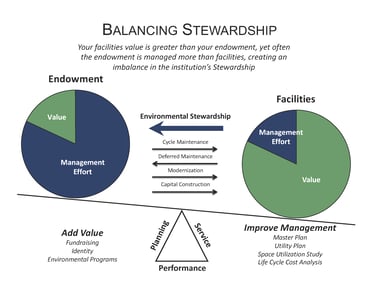How an FCA laid the foundation for Energy Savings and a Network of System Performance
Stuart Country Day School of the Sacred Heart, an all-girls independent school located in Princeton, New Jersey, recently released an article published within NBOA’s NetAssets magazine that discusses the School’s path to a fully integrated, connected campus through a sophisticated building management system, powered by the Internet of Things (IoT). You can read the full article here.
Independent schools are endowed with the gift that keeps on taking – bespoke architecture and grounds that support the education of their students that demands continuous upkeep and meticulous operations management of facilities that may not always receive the attention required. Our team has often noted the extreme caution exercised by independent schools when handling fiscal responsibilities related to their  endowment, but not providing the same level of scrutiny to the physical plant which is often the greater asset. This leads to an “imbalance” in facilities stewardship, as described by the adjacent graphic. When the endowment and facilities are properly balanced, managing capital and operating budgets becomes easier. A Facilities Condition Assessment (FCA) assists with budget management by uncovering facilities exposures and risks and assigning monetary values to them.
endowment, but not providing the same level of scrutiny to the physical plant which is often the greater asset. This leads to an “imbalance” in facilities stewardship, as described by the adjacent graphic. When the endowment and facilities are properly balanced, managing capital and operating budgets becomes easier. A Facilities Condition Assessment (FCA) assists with budget management by uncovering facilities exposures and risks and assigning monetary values to them.
The Stone House Group performed an FCA for Stuart Country Day School of the Sacred Heart in 2014 to assess the School’s various energy systems and facilities components. The identified deferred maintenance represented the School’s struggle to integrate old systems with new, and effectively manage the way its facilities consumed energy. With an exhaustive list of deferred maintenance and a renewed sense of determination, the School hired a Director of Facilities and Sustainable Planning and committed to increasing sustainability and energy efficiency on campus. Our team assisted the School by obtaining incentives through the New Jersey Pay for Performance (P4P) program to pay for the integration of systems on campus to a sophisticated Building Management System (BMS), allowing them to closely monitor system operations and reduce energy consumption by 30%.
Finally, the school installed Measurement and Verification sensors on their systems, creating a comprehensive map of their facilities. Occupancy, humidity, and carbon dioxide sensors worked together to optimize outdoor air ventilation, supply temperature and air flow sensors created greater visibility for system performance, and local control settings improved thermal comfort. Since the sensors were installed in 2015, the School realized a 43% reduction in energy use.
Furthermore, the sensors proved to be an exceptionally valuable tool during the Coronavirus Pandemic. The performance of ventilation and distribution systems could be verified and adjusted, ensuring the spaces are as safe for learning as possible.
The Stone House Group has assembled industry best practices on HVAC strategies for safeguarding wellness, which can be viewed here.
The wealth of information available not only became a useful tool for facility administrators, but also became a learning tool for students. Research projects could be conducted on campus, about the campus, promoting the “campus as a living laboratory” theme for which schools strive to achieve.